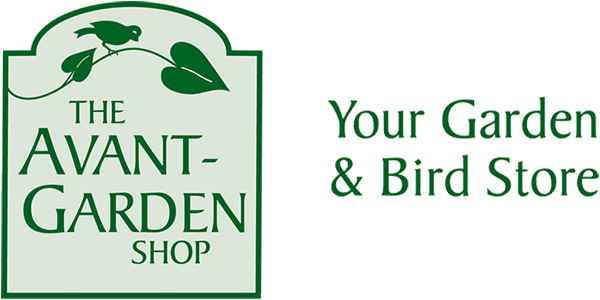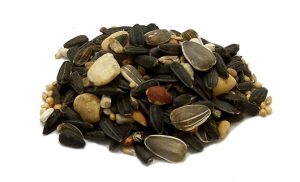 ? CHEX TV airdate: Friday, Feb. 6th, 2015 Click link to watch this episode. I knew our bird food was good stuff. ?But it wasn’t until I picked some other “bird food” up at a box store that I realized HOW good! On this episode of the Garden Gate I will show you how to tell the difference between good and bad bird food. ?And the birds will also tell you! ?If you don’t have any birds at your feeders, there is very likely something wrong with the food. Many box store brands are filled with seeds that the birds don’t like. ?If the ingredients list includes “grains”, mostly like that is wheat. ?Pheasants and chickens may eat wheat, but backyard birds don’t. ?Also ingredient lists sometimes note that “oil may be used to suppress dust.” ?Birds don’t like oil and dust anymore than you do! ?The box store bag I picked up felt so dusty I was shocked! Even black oil sunflower varies from store to store. ?It is sorted be weight. ?Lightweight seeds are separated by being blown off a conveyor belt. The light weight seeds go in the cheaper bags and you get more shell than you do seed! ?Birds will toss most of these seeds on the ground because it’s not worth their time and energy to open the shells for little reward. Our bird food is filled with only the good stuff. ?No filler. No dust. No oil. NO wheat! ?You’ll find you have much more activity at your feeders and a much wider variety of birds. The sunflower seeds are plump and fresh! Ask for our most popular blend “Seasons Woodland.” And, finally if you’re thinking quality bird food is more expensive, then think again. ?Depending on the bird food you choose, 10lbs is less than $15.00 and there is NO waste. ?Give ours a try! I’m sure you’ll be surprised with the results.
? CHEX TV airdate: Friday, Feb. 6th, 2015 Click link to watch this episode. I knew our bird food was good stuff. ?But it wasn’t until I picked some other “bird food” up at a box store that I realized HOW good! On this episode of the Garden Gate I will show you how to tell the difference between good and bad bird food. ?And the birds will also tell you! ?If you don’t have any birds at your feeders, there is very likely something wrong with the food. Many box store brands are filled with seeds that the birds don’t like. ?If the ingredients list includes “grains”, mostly like that is wheat. ?Pheasants and chickens may eat wheat, but backyard birds don’t. ?Also ingredient lists sometimes note that “oil may be used to suppress dust.” ?Birds don’t like oil and dust anymore than you do! ?The box store bag I picked up felt so dusty I was shocked! Even black oil sunflower varies from store to store. ?It is sorted be weight. ?Lightweight seeds are separated by being blown off a conveyor belt. The light weight seeds go in the cheaper bags and you get more shell than you do seed! ?Birds will toss most of these seeds on the ground because it’s not worth their time and energy to open the shells for little reward. Our bird food is filled with only the good stuff. ?No filler. No dust. No oil. NO wheat! ?You’ll find you have much more activity at your feeders and a much wider variety of birds. The sunflower seeds are plump and fresh! Ask for our most popular blend “Seasons Woodland.” And, finally if you’re thinking quality bird food is more expensive, then think again. ?Depending on the bird food you choose, 10lbs is less than $15.00 and there is NO waste. ?Give ours a try! I’m sure you’ll be surprised with the results.
Back Yard Bird Watching
Garden Gate: Episode 55 – New Feeders
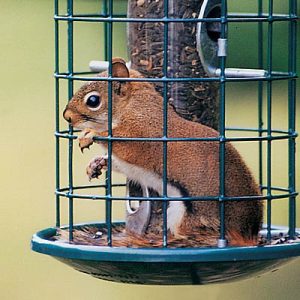 Click link to watch this episode. So you have a new feeder! ?Yay! ?You filled it up with bird food. Hung it in a tree. ?It looks good. ?You can see it from the kitchen window and are ready to enjoy those little chirpers. Then you waited. No birds. Days go by. Still no birds. ?What’s going on you say? ?It’s frustrating, but there are often good reasons why you don’t see any birds. On this episode of The Garden Gate on CHEX TV I give some quick tips about why you may not be seeing birds and things you can do to hopefully get them to enjoy your new bird feeder. ?I hope you’ll join me!
Click link to watch this episode. So you have a new feeder! ?Yay! ?You filled it up with bird food. Hung it in a tree. ?It looks good. ?You can see it from the kitchen window and are ready to enjoy those little chirpers. Then you waited. No birds. Days go by. Still no birds. ?What’s going on you say? ?It’s frustrating, but there are often good reasons why you don’t see any birds. On this episode of The Garden Gate on CHEX TV I give some quick tips about why you may not be seeing birds and things you can do to hopefully get them to enjoy your new bird feeder. ?I hope you’ll join me!
Garden Gate: Episode 52-Discouraging large birds
CHEX TV airdate: Friday Dec. 12th, 2014 Click link to watch it here! 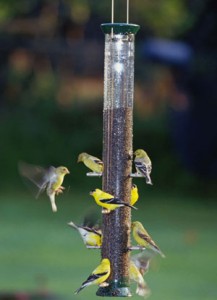 Feeding and watching the birds is a wonderful past time. ?You can spend hours watching the chickadees coming in to grab a seed one after another. ?Polite little birds! Then there are the goldfinches. They have such a pretty song, I could listen to them all day. They will come in large flocks and sit all day taking turns eating your Nyger seed. Bright red Cardinals appear and we almost jump for joy! ?When they are courting or have little ones to feed you might enjoy dad helping to pass on a seed or two. ?FUN! Aww, b
Feeding and watching the birds is a wonderful past time. ?You can spend hours watching the chickadees coming in to grab a seed one after another. ?Polite little birds! Then there are the goldfinches. They have such a pretty song, I could listen to them all day. They will come in large flocks and sit all day taking turns eating your Nyger seed. Bright red Cardinals appear and we almost jump for joy! ?When they are courting or have little ones to feed you might enjoy dad helping to pass on a seed or two. ?FUN! Aww, b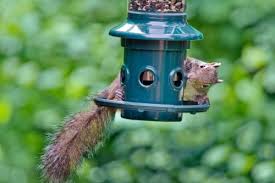 ut then the fun ends. Sir Squirrel or Gastly Grackle moves in….birds fly away and these two devour everything in site! On this episode of The Garden Gate, I’ll give you some tips on types of feeders that discourage squirrels and grackles as well as bird food that they don’t like. Feel free to drop in to see these feeders or to get more information. We’re here to help and to make your back yard bird feeding more enjoyable! Note: we do not recommend bird food with cayenne. ?If a squirrel gets the cayenne pepper in their eyes they can do serious damage to their eyes. ?Also, it has been shown that it affects birds stomachs. They can’t necessarily taste it, but their little tummies don’t like it. ?
ut then the fun ends. Sir Squirrel or Gastly Grackle moves in….birds fly away and these two devour everything in site! On this episode of The Garden Gate, I’ll give you some tips on types of feeders that discourage squirrels and grackles as well as bird food that they don’t like. Feel free to drop in to see these feeders or to get more information. We’re here to help and to make your back yard bird feeding more enjoyable! Note: we do not recommend bird food with cayenne. ?If a squirrel gets the cayenne pepper in their eyes they can do serious damage to their eyes. ?Also, it has been shown that it affects birds stomachs. They can’t necessarily taste it, but their little tummies don’t like it. ?
Garden Gate: Episode 42 – Plants for birds
CHEX TV airdate: July 25th, 2014 Click here to watch this episode. Birds love seed that you put out in your bird feeders, but in the summer they go crazy for natural berries and seeds that they find in your garden. On this episode I’ll highlight a few plants they you could easily incorporate into your garden. I especially love seeing Cedar waxwings in the late summer devouring the Mountain ash berries. ?I always get customers in commenting on “this flock of birds.” ?They come in large numbers and hang out in one tree for a day or two until the berries are gone. Then they move onto the next one. 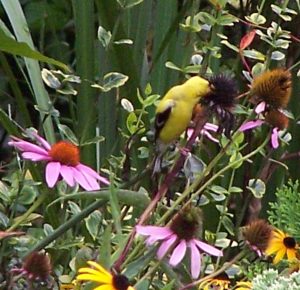 It’s also a great idea to leave some of your plants standing late and through the winter so the birds can pick out all of the seeds. Echinacea is a great plant that the finches especially enjoy. So leave those seed heads standing as long as possible! If you incorporate a variety of plants, trees and shrubs you’ll see more variety of birds. They each have their favourite. This All about Birds website as well as many others can give you lists of plants that birds love. ?Or drop by the store and we can give you some ideas as well. Just remember “Variety is the spice of life!”
It’s also a great idea to leave some of your plants standing late and through the winter so the birds can pick out all of the seeds. Echinacea is a great plant that the finches especially enjoy. So leave those seed heads standing as long as possible! If you incorporate a variety of plants, trees and shrubs you’ll see more variety of birds. They each have their favourite. This All about Birds website as well as many others can give you lists of plants that birds love. ?Or drop by the store and we can give you some ideas as well. Just remember “Variety is the spice of life!”
Garden Gate: Episode 37 – Hummingbirds and Orioles
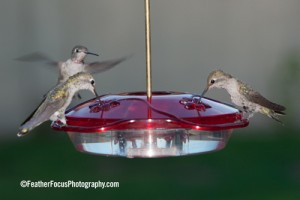 CHEX TV Air date: May 16th, 2014 Click link to watch this episode Hummingbirds and orioles are almost here. Visit www.hummingbirds.net to see where they have been spotted! On this episode of The Garden Gate I’ll help you choose a good quality hummingbird feeder that will last for many years.
CHEX TV Air date: May 16th, 2014 Click link to watch this episode Hummingbirds and orioles are almost here. Visit www.hummingbirds.net to see where they have been spotted! On this episode of The Garden Gate I’ll help you choose a good quality hummingbird feeder that will last for many years.
I often have customers ask me, despite being diligent about filling their feeders,?why they don?t seem to get any hummingbirds. There could be a few reasons. Here are some tips to help you out.
-choose a quality feeder that has red colour on it -hummingbirds will not feed from feeders with insects in them, so ensure your feeder has an ant moat to keep out ants and bee guards to keep out the bees. -avoid feeders with yellow flowers as this attracts more bees -get your feeders out early (May 1st in our region) -fill with sugar solution of 4 parts water to 1 part sugar. Ensure the sugar is dissolved. It?s not necessary to boil the water as long as the sugar dissolves. -you may also consider a prepared mix as they often include extra?vitamins and nutrients?(like giving the birds orange juice vs. pop) -do not use food colouring -hang your feeder in a visble location but not the full sun -change the liquid weekly (more often in hot weather) -clean the feeder each time -hang a red scarf or red flag nearby initially to attract the bird. They are highly attracted to the red.
Hummingbirds love certain types of flowers. So include a wide variety whenever possible. Here are some of my favourites to attract the hummingbirds: Lantana, Butterfly bush, Lamium, Salvia, Trumpet vine, Morning glory, Columbine, Honeysuckle, Bee Balm, Fushia, Weigela, Petunia?s, Impatiens and even Scarlet runner beans!
Orioles 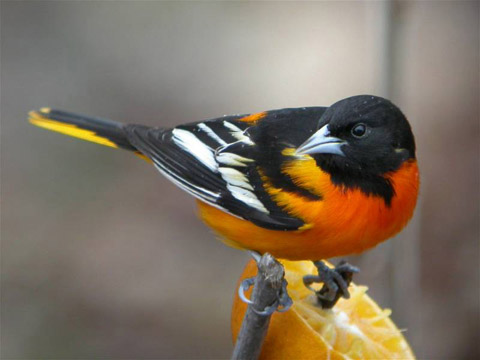 Like hummingbirds are attacted to red, Orioles are attracted to orange. They also drink nectar in the same concentration at the hummingbird.? So pick out a feeder similar to the one recommended above but in orange!? Orioles will also eat orange slices and grape jelly!? Feeders are available for both of these options.
Like hummingbirds are attacted to red, Orioles are attracted to orange. They also drink nectar in the same concentration at the hummingbird.? So pick out a feeder similar to the one recommended above but in orange!? Orioles will also eat orange slices and grape jelly!? Feeders are available for both of these options.
Orioles are a little harder to attract and keep around. They don?t cruise through gardens as easily as the hummingbirds do.? They can be found where tall trees exist, at the edges of forests and along rivers. So not everyone can attract the oriole.
Orioles also tend to move with the bloom. So if flowers have finished blooming in your yard, the bird?may continue to move north to find more blooms to drink the nectar from.
I have been able to keep orioles in my garden but not after being very consistent about providing them with a food source. It took them about 4 years of feeding before they finally stayed for a longer period than normal. So far I have been unable to find a nest, but I have seen the young at my feeder.
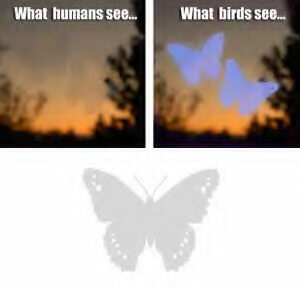 And one more tip for this time of year. ?Put stickers on your windows to prevent bird strikes.
And one more tip for this time of year. ?Put stickers on your windows to prevent bird strikes.
These Window Alert stickers are made of an ultraviolet product that the birds can see. It acts like a giant stop light for them, but you barely notice the stickers. So if you don’t like those big black bird stickers from years ago, these are for you!
There are 4 stickers in each package. Place them on the outside of your windows. The more you use the better! ?Replace annually.
Come in to win!
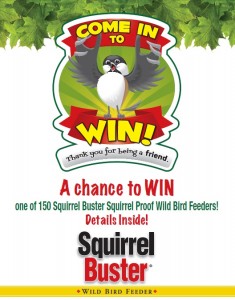
Come in to win a Squirrel Buster!
Starting?Monday Feb. 10th, drop by the store for your secret code. ?Use the secret code to enter to win one of 150 Squirrel Buster bird feeders!
You can enter online or by phone. Enter early. Enter OFTEN! No purchase required.
Prizes available:
120 Squirrel Buster Standard bird feeders
18 Squirrel Buster Finch bird feeders
12 Squirrel Buster Plus bird feeders
The Squirrel Buster line of bird feeders really do work! ?We have many happy customers who can attest to that fact. ?If you’d like to learn more about the different types of Squirrel Buster feeders, visit the manufacturers website. www.bromebirdcare.com On their website you can also watch some video of the birds enjoying the feeders!
Garden Gate: Episode 32 – Grackles and Starlings with guest Drew Monkman
Chex air date: February 21st, 2014
Click here to watch this episode of The Garden Gate.
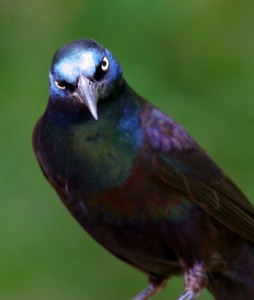 Grackles and starlings can be so annoying when they find your bird feeders. ?They eat so much, come in large flocks and scare away the prettier birds like cardinals. (Photo: www.billhubick.com)
Grackles and starlings can be so annoying when they find your bird feeders. ?They eat so much, come in large flocks and scare away the prettier birds like cardinals. (Photo: www.billhubick.com)
During this episode of The Garden Gate I’ll speak with local naturalist and author about these birds and we’ll discuss ways to keep them out of your bird feeders.
Did you know that they don’t like safflower? ?That’s one way to discourage them. Also the Squirrel Buster Plus bird feeder has a few design tricks that also discourage the grackle.
Drew Monkman is the author of Nature’s Year in the Kawarthas and also an updated version called Nature’s Year?which is available at The Avant-Garden Shop. A great book for the cottage, for teaching children about the every day changes in our environment and just about anyone else who loves exploring the outdoors.
Garden Gate: Episode 31 – Bats and white nose syndrome
Chex TV air date: Feb. 7th, 2014
Click here to watch this episode of the Garden Gate.
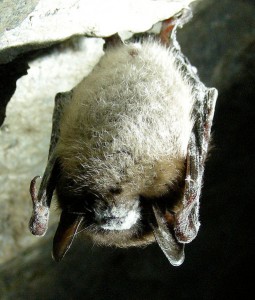 Not everyone is a fan of bats. ?But bats eat 1000’s of mosquitoes everyday and should be encouraged in our gardens and yards. ?You can put up bats houses to attract them. We carry a few styles made locally by Animal House Creations.?
Not everyone is a fan of bats. ?But bats eat 1000’s of mosquitoes everyday and should be encouraged in our gardens and yards. ?You can put up bats houses to attract them. We carry a few styles made locally by Animal House Creations.?
Bats are on a steady decline all across the country because of a fungus called?White nose syndrome.
A local naturalist will be our guest this week. Drew Monkman, will tell us more about this terrible disease and how it is affecting our bats.
Garden Gate: Episode 29 – Keeping birds warm during the winter
CHEX Air date: Friday January 10th, 2014
Click here to view this episode of The Garden Gate.
We have been having some extremely cold weather conditions since late November this year. ?Ice storms, strong wind conditions and high snowfall mean food sources are covered. Birds need to eat almost constantly during the day to retain enough energy through our long winter nights. Here are a few things you can do to help.
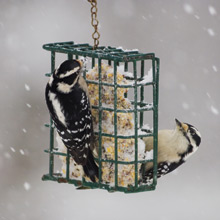 FOOD
FOOD
Keep feeders full. Birds are more attracted to feeders that are full. ?They can see the seed and then know that it’s worth their while to visit your restaurant.
Keep feeders clean. If seed gets frozen or some moisture gets into the feeder, the seed may not dispense properly or it may go moldy or rancid. Checking your feeders often and changing seed regularly is very important. ?If birds seem to be ignoring your feeders, it may be that the seed is bad or jammed inside the feeder.
Provide lots of peanuts for extra energy. Whether in the shell or out of the shell. Birds love peanuts! Peanuts are a favourite for Blue Jays, Woodpeckers, Nuthatches and Chickadees. Even cardinals like peanuts! Click this link to visit our website to see some peanut and suet feeders.
Suet is also an excellent food source through the winter. Make sure that you get good quality suet without filler such as cornmeal and millet.? Suet with cornmeal can get moldy easily as the cornmeal holds moisture. Avoid cornmeal. The more fat, peanuts and sunflower seeds the better!
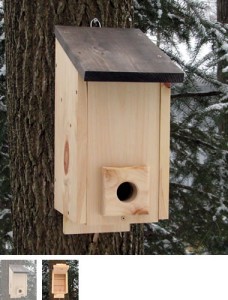 SHELTER
SHELTER
Besides food you can also provide shelter. We carry this roosting box. Birds will crowd together inside the roosting box to share energy. If you’re going to make a box yourself, it’s similar to a bird house, but there are no ventilation gaps. This allows the space to warm up as the birds huddle together.
Birds will also huddle together in the branches of coniferous trees like spruce, pine and cedar. Plant coniferous trees next spring and put your feeders close by so the birds can go back and forth between the tree and the feeder.
Note: Cardinals love cedar trees!
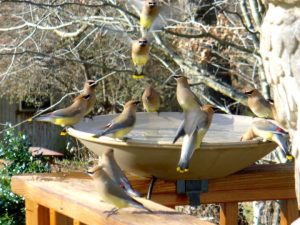 WATER
WATER
Heated bird baths are great in the winter. They keep the water just above freezing and birds flock to this easily accessible water source. You don’t need to worry if they bathe, because their feathers will move the water away from their bodies. They need to keep their feathers clean of dust, dirt and insects. ?Their bodies are also warm so the water evaporates before it can freeze. It?s important to keep birds well fed so they are generating energy to help keep their body temp up.
Birds can melt snow in their mouths, but it takes a lot of extra energy to do that, so they prefer and open water source. If there is no other open water source near you, you’ll be surprised at how many birds you’ll see at your bath!
Garden Gate: Episode 21-Suet and Peanut Feeders
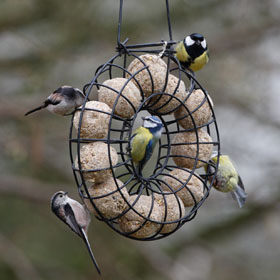 CHEX TV air date: Fri. Sep. 20th, 2013
CHEX TV air date: Fri. Sep. 20th, 2013
Click here to view this episode of ?The Garden Gate.
Blue Jays, woodpeckers, chickadees, nuthatches and many other birds love peanuts and suet.? Even cardinals! The peanuts and suet give them the extra carbohydrates they need to stay warm through the long winter nights.
There are a variety of feeders in which you can offer peanuts. Peanuts in the shell work nicely in the wreath feeders or other feeders with large openings.? These feeders offer some challenge to the bird, making them take some extra time to get the seed out. This means you get a great look at the bird while he is struggling to pull the seed out or peck at it until the delicious kernel is retrieved.? You can also offer shelled peanuts which birds peck at through a mesh and get little kernels which they gobble down quickly.? Shelled peanuts are actually more cost effective and also less messy. No shells left behind to clean up!
Please buy fresh peanuts!? Old stale peanuts can go rancid and the bird will not eat them. Our seeds are the freshest you can get. Your birds will love them!
Suet can also be offered year round, providing that you choose good quality suet.? Poor quality suet will melt in the summer heat and also contains many types of filler that the birds don?t enjoy and will leave behind.? At The Avant-Garden Shop, we offer Millcreek bird food and also suet.? All of their suet is double rendered, which means it is very dense and doesn’t melt or fall apart easily. The Summer Nut suet is even thicker and will not melt even in our summer heat.
We also offer pure suet, which grackles and starlings tend to shy away from. It is their least favourite. It is a softer suet and will melt in high heat, so should only be offered late in the season and through the winter.
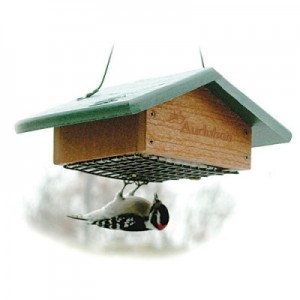 There are a variety of suet feeders that hold the suet blocks. We have upside down suet feeders (Starlings dislike this style), feeders with tail props (which the Hairy woodpecker loves) and also the regular square cages. We have the cages for single suet cakes, two or even four suet cakes. ?We also have a suet log feeder which has holes in which you can push a special “peanut butter” type suet.
There are a variety of suet feeders that hold the suet blocks. We have upside down suet feeders (Starlings dislike this style), feeders with tail props (which the Hairy woodpecker loves) and also the regular square cages. We have the cages for single suet cakes, two or even four suet cakes. ?We also have a suet log feeder which has holes in which you can push a special “peanut butter” type suet.
For the Christmas season we also offer solid seed wreaths, suet ?acorns? and other fun items that you can give as a gift to the person who wants little or nothing.? It?s a ?gift for the birds!?
